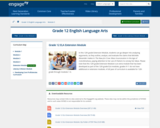Common Sense Education Digital Citizenship Curriculum VideoEquitable and Inclusive Curriculum The CSDE believes in providing a set of conditions where learners are repositioned at the center of curricula planning and design. Curricula, from a culturally responsive perspective, require intentional planning for diversity, equity, and inclusion in the development of units and implementation of lessons. It is critical to develop a learning environment that is relevant to and reflective of students’ social, cultural, and linguistic experiences to effectively connect their culturally and community-based knowledge to the class. Begin by connecting what is known about students’ cognitive and interdisciplinary diversity to the learning of the unit. Opposed to starting instructional planning with gaps in students’ knowledge, plan from an asset-based perspective by starting from students’ strengths. In doing so, curricula’s implementation will be grounded in instruction that engages, motivates, and supports the intellectual capacity of all students.Empowering Thoughtful Digital Citizens:Digital citizenship is a critical skill that empowers students to navigate the complex digital landscape with wisdom, empathy, and responsibility. We strongly believe in a whole-school approach to digital citizenship that engages educators, school leaders, and families in supporting students' technological growth. Our model curriculum is designed to equip students from kindergarten through high school with essential skills to safely and thoughtfully engage with technology, fostering digital literacy, critical thinking, and social-emotional learning. By creating intentional learning spaces that encourage in-person connections, teach impulse control, and develop media literacy, we aim to prepare students to appreciate the nuanced nature of technology use, protect their well-being, and cultivate healthy digital habits that will serve them throughout their lives.Course Description: In this eleventh-grade course, students examine digital wellness and responsible online behavior. The curriculum explores technology design's role in user engagement, social media age restrictions, and strategic digital footprint management. Students learn about online disinhibition effects, audience-aware communication, and critical evaluation of clickbait content. The course emphasizes developing balanced digital habits while maintaining authentic online presence.Upon completion of Grade 11, students should have a deeper understanding of:Analyze and draw conclusions about a series of photos depicting device use.Use online resources to track arguments for and against whether we are addicted to our devices.Complete a short writing assignment analyzing one or more aspects related to the device addiction debate.Explain why websites that collect personal information have an age requirement of 13 in the United States.Identify the risks of targeted advertising, especially when it is targeted to children.Use the Take a Stand thinking routine to explore different perspectives about what age is best for starting to use social media.Learn that they have a public presence online called a digital footprint.Recognize that any information they post online can help or hurt their future opportunities (college admission, employment, etc.).Create a vignette that shows how a positive digital footprint can help someone take advantage of an opportunity.Apply the idea of code-switching to how they use phones and other devices in and outside of school.Consider different ways that code-switching online can make communication more meaningful and effective.Write an example post or message that uses code-switching to communicate with an online audience.Define "online disinhibition" and describe how it can be both positive and negative.Explain how anonymity, lag time, and lack of nonverbal cues all contribute to online disinhibition.Analyze how online disinhibition can cause cyberbullying and brainstorm ways to counter it.Describe how advertisers and publishers make money through online advertising.Describe how clickbait can contribute to the spread of fake news and disinformation.Use the Take a Stand thinking routine to consider different perspectives about whose responsibility it is to fight fake news and disinformation.Aligned Core Resources:Core resources is a local control decision. Ensuring alignment of resources to the standards is critical for success. The CSDE has identified Common Sense Education Digital Citizenship Curriculum as a highly aligned core curriculum after a rigorous review process. Transferable Skills Addressed in the Course: Media Balance & Well-Being Privacy & Security Digital Footprint & Identity Relationships & Communication Cyberbullying, Digital Drama & Hate Speech News & Media Literacy Family Engagement Opportunities:Family engagement is fundamental to our digital citizenship efforts, rooted in a whole community approach that recognizes families as essential partners in supporting students' technological development. We are committed to providing family engagement resources, and opportunities to support healthy digital habits, establish open communication about technology use, and model responsible digital behavior. Recognizing that parents and caregivers have diverse concerns about media, technology, and devices, we aim to be a supportive resource in guiding their children's digital experiences. By fostering ongoing communication and partnership, we create a dynamic support system that addresses challenges across school and home environments, ultimately strengthening students' digital citizenship skills.


